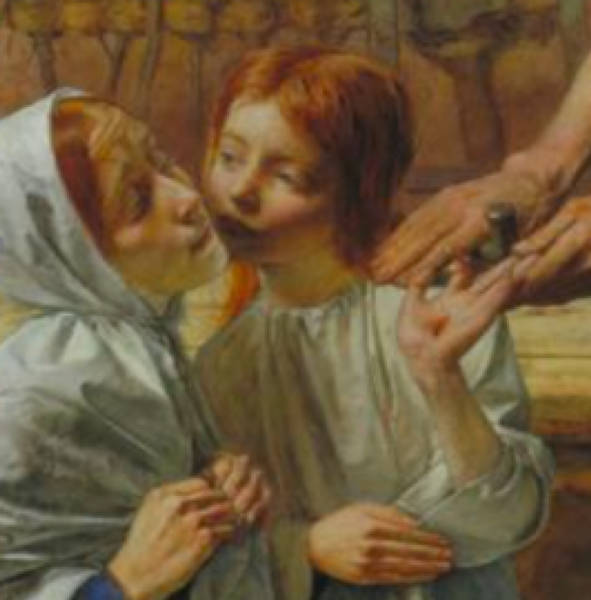
Charles Allston Collins. Berengaria's Alarm for the safety of her husband, Richard Coeur de Lion, awakened by the sight of his girdle for sale at Rome (The Pedlar). 1850. Oil on canvas, 39 7/8 x 42 inches. Manchester City Art Galleries 1896.1; purchased from Harry H. Martyne, 1896. Click on image to enlarge it.
We have already examined the use of typological symbolism in the Druids picture and Millais's painting of Christ's prefigurative wound in the carpenter's shop, and we can now compare them to Charles Collins's The Pedlar, which is now known as Berengaria's alarm for the safety of her husband, Richard Coeur de Lion, awakened by the sight of his girdle offered for sale at Rome. Like A Converted British Family sheltering a Christian Priest from the Persecution of the Druids, Collins's picture employs types in a work of essentially secular history. Furthermore, by establishing a prefigurative relationship between Joseph, Christ, and Richard the Lion-hearted, Berengaria's Alarm resembles Hunt's earlier Rienzi which is also about a secular "saviour."


John Everett Millais. Christ in the House of His Parents. 1849-50. Oil on canvas, 34 x 55 inches; 864 x 1397 mm. Tate Britain, London. N03584. Purchased with assistance from the Art Fund and various subscribers 1921. Image released under Creative Commons CC-BY-NC-ND. Click on image to enlarge it. [Click on images to enlarge them.]
Collins has chosen to portray the queen's recognition of her husband's girdle within a symbolic setting that clearly establishes the typological parallels. The pedlar offers his wares to the queen and her ladies, who stand before two tapestries, one of which bears the legend "Ye hystory of Joseph" — an Old Testament story that had provided the subject for at least two recent paintings: John Bridges exhibited Jacob deceived by Joseph's coat of many colours at the 1843 British Institution, using as an epigraph the text which appears on the manuscript in Collins's version; and Edward Fryer had a picture of The Brethren of Joseph bringing the Garment to Jacob at the British Institution in 1838. It would be interesting to discover if Collins drew upon these or other versions of the popular story for his tapestries in Berengaria's Alarm.
The artist enforces his point visually by relating Berengaria's stance to the posture of the brothers while the pedlar's echoes that of the patriarch in the tapestry. As the evil brothers brought the coat of many colors to Jacob to convince him that his favorite son was dead, the pedlar's action convinces the queen that Richard is dead or in great danger. The parallel is not complete because, although Jacob's recognition of the garment convinced him of his son's death, Berengaria's leads eventually to her husband's rescue. Collins enforces his point literally juxtaposing the text from Genesis with one from the Gospel of John - on the floor near the seated lady-in-waiting is a manuscript scroll bearing the words "And he knew it and sayde it is my sonne hys coate an evil beaste hath devoured hym Joseph is without doubte rent in pieces"; this lies upon a Latin manuscript of the Gospel of St. John which is open to the first page, while beneath it appears the blue cover of a copy of the Gospels bearing the image of Christ and the emblems of the four Evangelists. To the left of these three volumes is a smaller book on whose cover appear six barely perceptible emblems, each apparently with a scriptural reference. At least one of these ovals seems to echo the opposition of standing and kneeling figures in the main action. The idea that Joseph was a type of Christ was an exegetical commonplace, and interpreters could point to the fact that the boy's robe was dipped in goat's blood to establish a connection to the levitical sacrifice as well. Collins uses the tapestry and the text from Genesis to establish the relationship with Richard, and to this he adds the opening lines from the Gospel of John to make certain the spectator understands the prefigurative symbolism. For an extended discussion of such secularized types, see the relevant sections of Chapter 5 and Chapter 7 in Victorian Types.
Created December 2001 Last modified 29 October 2020
